|
|
Recent Progress in High-quality Perovskite CH3NH3PbI3 Single Crystal
CHU Zeng-Yong, LI Gao-Lin, JIANG Zhen-Hua, WANG Chun-Hua
2018 Vol. 33 (10): 1035–1045
 Abstract
Abstract(
2042 )
 HTML
HTML(
68)
 PDF
PDF(4523KB)(
2585
)
Organic-inorganic hybrid halide perovskites have attracted a huge amount of research interest and arised new research upsurge due to its broad absorption range, low trap density, low carrier recombination, and other excellent optoelectronic properties. Perovskite solar cells have shown great potential for application with maximum power conversion efficiencies evolving from 3.8% to 22.1% in just a few years. Single crystal has extremely low defect density and minimal interface defect than polycrystalline materials. Several research groups successfully cultivated large-sized perovskite single crystals, finding that perovskite single crystal is an ideal material for design and fabrication of photovoltaic devices for better light-response than polycrystalline and thin-film materials. Among all kinds of perovskite materials, CH3NH3PbI3 is one of the most widely studied and applied perovskite materials. This paper reviews the study of CH3NH3PbI3 single crystal recently, introducing its structure and superior characteristics. Particularly, growth methods and applications of perovskite single crystals are highlighted. Finally, the development trend of perovskite single crystals is prospected.
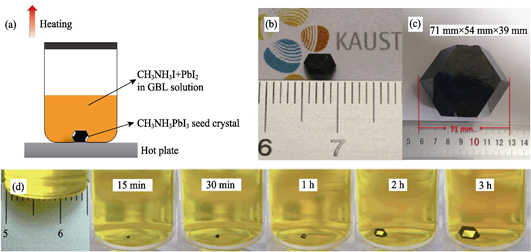
|
|
|
Lead-free Nonlinear Dielectric Ceramics for Energy Storage Applications: Current Status and Challenges
DU Hong-Liang, YANG Ze-Tian, GAO Feng, JIN Li, CHENG Hua-Lei, QU Shao-Bo
2018 Vol. 33 (10): 1046–1058
 Abstract
Abstract(
1650 )
 HTML
HTML(
69)
 PDF
PDF(5189KB)(
2151
)
Compared to polymers and their nanocomposites, dielectric ceramics are considered as promising candidates for the pulsed-power devices because of their excellent temperature stability and good anti-fatigue characteristic. Nevertheless, relatively low energy storage density is the main disadvantage for dielectric ceramics, which does not meet the requirement of miniaturization for pulsed-power devices. Therefore, how to improve the energy storage density of dielectric ceramics has become one of hot topics on the research of functional ceramics in recent years. In this paper, the basic principle of the capacitor for electric energy storage was introduced firstly and then the research advances of BaTiO3-based, BiFeO3-based, (K0.5Na0.5)NbO3-based lead-free relaxor ceramics and (Bi0.5Na0.5)TiO3-based, and AgNbO3-based lead-free anti-ferroelectric ceramics were reviewed based on our group’s research, in which the composition design strategies of different material systems were especially summarized. Finally, the opportunities and challenges of lead-free nonlinear energy-storage ceramics were analyzed, and the coping strategies as well as the future development direction were also proposed.
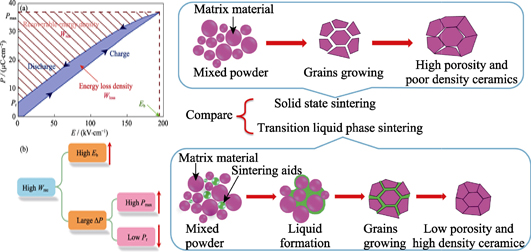
|
|
|
Dielectric and Energy Storage Property of Dielectric Nanocomposites with BaTiO3 Nanofibers
WANG Lu, KONG Wen-Jie, LUO Hang, ZHOU Xue-Fan, ZHOU Ke-Chao, ZHANG Dou
2018 Vol. 33 (10): 1059–1064
 Abstract
Abstract(
865 )
 HTML
HTML(
17)
 PDF
PDF(2249KB)(
1179
)
In this study, BaTiO3 nanofibers were synthesized by a two-step hydrothermal method and subsequently incorporated into poly(vinylidene fluoride-co-hexafluoropropylene) (P(VDF-HFP)) matrix to prepare nanocomposites for energy storage application. The crystalline phase, morphology and microstructure of BaTiO3 nanofibers were observed by X-ray diffraction, scanning electron microscopy and transmission electron microscopy, respectively. The dielectric properties and energy storage performance of the nanocomposites were characterized by dielectric and ferroelectric analyzer. The BaTiO3 nanofibers with tetragonal phase structure exhibited high aspect ratios, good dispersibility and compatibility in polymer matrix. The effects of volume fraction of BaTiO3 nanofibers on the dielectric constant, breakdown strength and discharged energy density of the nanocomposites were investigated systematically. The dielectric constant of the BaTiO3-P(VDF-HFP) nanocomposites remarkably improved with the increase of BaTiO3 nanofiber contents at the same frequency. At 1 kHz, the maximum dielectric constant of the composite with 20vol% BaTiO3 nanofibers is up to 30.69. The composite with 5vol% BaTiO3 nanofibers achieves the maximum energy storage density (4.89 J/cm3) and discharged energy density (2.58 J/cm3) at 240 kV/mm.
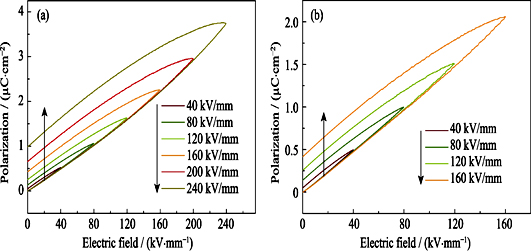
|
|
|
Synthesis and Property of Novel Li21Si5/Graphene Composites Anode for High Energy Lithium-ion Batteries
YANG Ke, HOU Chao, SONG Xiao-Yan
2018 Vol. 33 (10): 1065–1069
 Abstract
Abstract(
716 )
 HTML
HTML(
6)
 PDF
PDF(2384KB)(
1087
)
Taking advantage of simultaneous thermochemical lithiation and densification of spark plasma sintering, the Li21Si5/graphene nanocomposites with uniform distribution and high density were prepared. Due to the two-dimensional structure and excellent electrical conductivity of graphene, and the presence of a high proportion of tightly bonded interfaces of Li21Si5/graphene, the volume shrinkage of the active particles during the delithiation process was limited effectively, and the charge transport inside the active particles was enhanced dramatically. Therefore, the composite exhibits excellent electrochemical performance. The specific capacities of pre-delithiation and the first lithiation were 968 mAh∙g-1 and 1007 mAh∙g-1, respectively, which are 3 times as high as those of the commercial lithium-carbon compound. Its first Coulomb efficiency was 94.5% at the same time. Moreover, the specific capacity remained 590 mAh∙g-1 after 100 cycles, and the cyclic stability doubled compared to the composites prepared by carbon particles. Even at a high current density of 1 A∙g-1, the specific capacity can be maintained at 540 mAh∙g-1. This work provides a new approach for the development of lithium-rich alloy anode materials, which are promising in high energy density batteries, such as lithium ion-sulfur and lithium ion-oxygen systems.
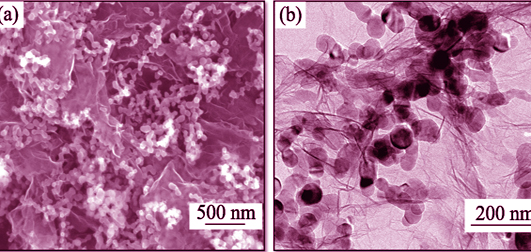
|
|
|
One-step Preparation and Electrochemical Performance of 3D Reduced Graphene Oxide/NiO as Supercapacitor Electrodes Materials
ZENG Yan-Fei, XIN Guo-Xiang, BULIN Chao-Ke, ZHANG Bang-Wen
2018 Vol. 33 (10): 1070–1076
 Abstract
Abstract(
1113 )
 HTML
HTML(
20)
 PDF
PDF(1456KB)(
1290
)
In this study, by using dispersions of graphene oxide (GO) and nickel nitrate (Ni(NO3)2·6H2O) with different ratios as precursors, three-dimensional self-supported reduced graphene oxide/NiO composites (3D rGO/NiO) were prepared via a one-step hydrothermal method. The analysis results (XRD, SEM, etc) indicate that NiO nanoparticles are homogeneously dispersed on the surface of graphene layers. The specific capacitance of 3D rGO/NiO composite reaches 1208.8 F·g-1 at a current density of 1 A·g-1 when the mass ratio of GO and Ni(NO3)2·6H2O is 1 : 4. With the current density increasing from 0.2 to 10 A·g-1, the specific capacitance retention of this composite is higher than 72.6%. After 10000 cycles, the specific capacitance of 3D rGO/NiO at a current density of 10 A·g-1 remained at 93% of the initial specific capacitance. All of these demonstrated that the composite possesses good rate capability and cycle stability. The 3D rGO/NiO composite has excellent electrochemical performances when compared with pure NiO or rGO, which is attributed to the synergistic effect between NiO and rGO.
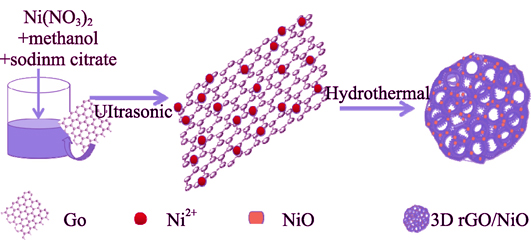
|
|
|
Influence of Calcining Temperature on the Property of Li0.33La0.56TiO3 Solid-state Ionic Capacitor
LU Dong-Liang, DAI Guang-Zhou, YAO Ying-Bang, TAO Tao, LIANG Bo, LU Sheng-Guo
2018 Vol. 33 (10): 1077–1082
 Abstract
Abstract(
676 )
 HTML
HTML(
8)
 PDF
PDF(1111KB)(
962
)
Li0.33La0.56TiO3 was synthesized under different calcination temperatures by using solid-state reaction method and assembled as LLTO solid-state ionic capacitors in this study. X-ray powder diffraction (XRD), scanning electron microscope (SEM), X-ray photoelectron spectroscopy (XPS), electrochemical impedance spectroscopy (EIS), and cyclic voltammetry (CV) were employed to investigate the influence of calcination temperature on the microstructure, morphology, ionic conductivity, and the energy storage property of the as-prepared products. Results indicate that Li0.33La0.56TiO3 calcined at higher temperature exhibited better performance, and the product synthesized at 1200℃ occupied the highest grain ionic conductivity (9.6×10-4 S/cm) with obvious double-layer capacitor characteristics, while the specific capacitor is nearly 3.52 mF/g at a 4 V potential window. Besides, the specific capacitor of the solid-state capacitor increases with the increment of grain ionic conductivity and effected by the contact area between electrode and solid electrolyte.
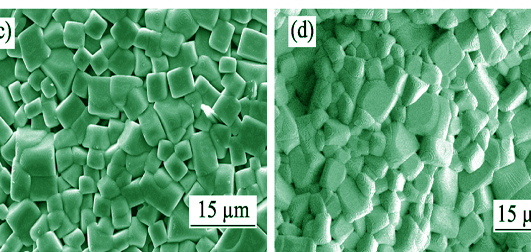
|
|
|
Controllable Synthesis of Vertically Aligned ReS2(1-x)Se2x Nanosheets with Tunable Chemical Compositions and Bandgaps
AO Wei-Dong, LIU Yan, MA Qing-Shan, LIU Huan, ZHOU Bin, ZHENG Xiao-Jia, YU Dong-Qi, ZHANG Wen-Hua
2018 Vol. 33 (10): 1083–1088
 Abstract
Abstract(
642 )
 HTML
HTML(
7)
 PDF
PDF(4370KB)(
1139
)
2D transition metal dichalcogenides (TMDs) have been extensively studied in recent years because of their appealing electrical and optical properties. Both morphology control and bandgap modulation of TMD alloys are critical for their applications in optoelectronics, photonics and nanoelectronics. In this work, the synthesis of vertically aligned ReS2(1-x)Se2x alloy nanosheets with tunable compositions on SiO2/Si substrate was achieved via CVD technology. The resulting ReS2(1-x)Se2x nanosheets were obtained by selenizing the vertically aligned ReS2 nanosheets at various temperatures for different durations. The ReS2(1-x)Se2x samples were characterized by XRD, SEM, XPS, HRTEM, elemental mapping, Raman spectra, and UV-Vis-NIR absorption spectra. Experimental results showed that the Se contents in ReS2(1-x)Se2x nanosheets can be gradually tuned from x=0 (pure ReS2) to x=0.86, and the bandgaps of the products were correspondingly modulated from 1.55 eV (800 nm) to 1.28 eV (969 nm). Moreover, the temperature and duration of selenization have huge effect on the morphology of the resulting ReS2(1-x)Se2x alloyed nanosheets, as evidenced by SEM observation. The vertical ReS2(1-x)Se2x alloy nanosheets may have significant application potential, e. g. , in the electrochemical catalysis, functional electeonic and optoelectronic devices.
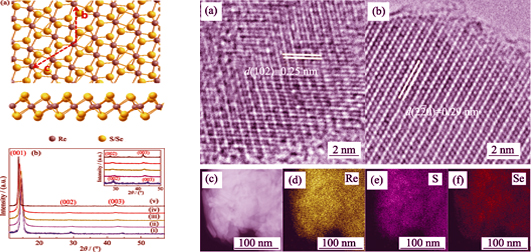
|
|
|
Microstructure of TiCuO Films on Copper Ion Release and Endothelial Cell Behavior
CHENG Dan, HUANG Bin, CHEN Tao, JING Feng-Juan, XIE Dong, LENG Yong-Xiang, HUANG Nan
2018 Vol. 33 (10): 1089–1096
 Abstract
Abstract(
659 )
 HTML
HTML(
8)
 PDF
PDF(5071KB)(
831
)
TiCuO films with different microstructures and Cu contents were prepared on Si and 316L SS substrates using DC magnetron sputtering. The microstructure and chemical composition of the films were analyzed by X-ray diffraction (XRD), transmission electron microscopy (TEM), X-ray energy dispersive spectroscopy (EDS), and X-ray photoelectron spectroscopy (XPS). Corrosion behavior and Cu ions release properties of the films were evaluated by electrochemical corrosion and simulated body-fluid immersion tests, respectively. Endothelial cell (EC) viability on the films was evaluated by CCK-8 assay in vitro. Un-doped TiO2 films exhibit rutile phases. After Cu incorporation, the TiCuO films consist of nano-crystalline grains of Cu2O on their amorphous matrix. The films with higher Cu contents are more susceptible to corrosion and release more Cu ions. The Cu-rich phases of the films result in corrosion. EC viability is enhanced by a certain concentration of Cu ions released from TiCuO films. All above results demonstrated that microstructures and Cu contents of TiCuO films play an important role in controlling copper ions release behaviors, and therefore affect the EC viability.
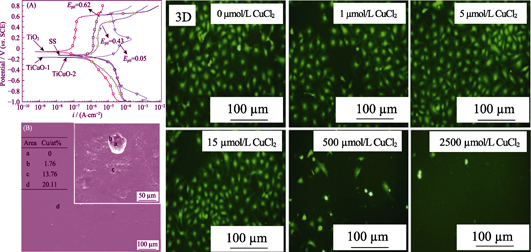
|
|
|
Facile Synthesis of Dendritic Mesoporous Silica Nanoparticles for Co-loading of Doxorubicin and Hemoglobin
PAN Shan, LI Yong-Sheng, SHI Jian-Lin
2018 Vol. 33 (10): 1097–1102
 Abstract
Abstract(
1259 )
 HTML
HTML(
24)
 PDF
PDF(3373KB)(
1217
)
Tumor hypoxia is a ubiquitous factor to cause the therapeutic resistance of drug or other treatments. To solve this problem, a facile biophase stratification approach was developed to fabricate dendritic mesoporous silica nanoparticles (DMSNs) with small particle size of 65 nm, high dispersity and excellent biostability through simply controlling the oil-water interfacial reaction. The resultant DMSNs were characterized by various techniques such as scanning electron microscope (SEM), transmission electron microscope (TEM), dynamic light scattering (DLS), and N2 adsorption-desorption analysis, etc. It is verified that DMSNs possess two types of pore size (2.7 nm and 5.4-6.8 nm), high specific surface (654.52 m2/g) and pore volume (1.26 cm3/g), which are capable to co-load DOX and Hb, simultaneously. Moreover, the mesopore size in the dendritic mesoporous layer could be tuned by changing the amounts of triethanolamine (TEA). The testing results from drug release, flow cytometry histograms, confocal laser scanning microscopy, and cell cytotoxicity demonstrate that DMSNs possess high efficiency of drug release (75.6%), durable releasing period (48 h) and significantly enhanced cell lethality (IC50= 20.6 μg/mL). These data demonstrate that such kind of dentritic mesoporous silica naoparticles has great potentials in drug delivery and tumor chemotherapy.
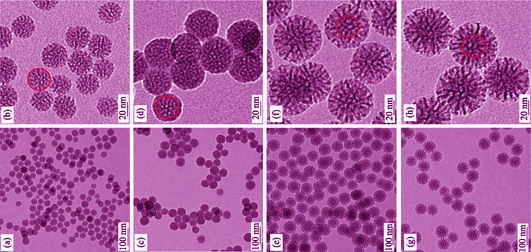
|
|
|
Fabrication and Fluorescence Biodetection of ZnO Nanorods Using Microfluidic Technology
GUO Ling-Xia, SHI Yu-Chen, ZHAO Zhen-Jie, LI Xin
2018 Vol. 33 (10): 1103–1109
 Abstract
Abstract(
840 )
 HTML
HTML(
14)
 PDF
PDF(9935KB)(
1008
)
A simple microfluidic chip was designed and fabricated, on which zinc oxide (ZnO) nanorods were synthesized by hydrothermal method. The influence of growth condition on morphology and crystal structure of ZnO nanorods were investigated by scanning electron microscope (SEM) and X-ray diffraction (XRD), respectively. Experimental results showed that densely packed ZnO nanorods could be prepared on microfluidic chip, with good crystallinity and c-axis orientation. The diameter and length of ZnO nanorods changed with heating methods and growth time. Moreover, fluorescence detection by ZnO nanorods, synthesized with different heating methods, were evaluated by FITC-labeled goat anti-bovine IgG. And the results revealed that ZnO nanorods synthesized on chip by localized heating showed better detection performance of fluorescein-labeled protein and good linearity from 10 pg/mL to 1 μg/mL with the correlation coefficient of 0.99209. The as-synthesized ZnO nanorods were further used to demonstrate detection of human α-fetoprotein (AFP), and achieved a superior limit of detection as low as 1 pg/mL. This work demonstrated that ZnO nanorods synthesized by microfluidic device allowed multiplexed fluorescence biodetection.
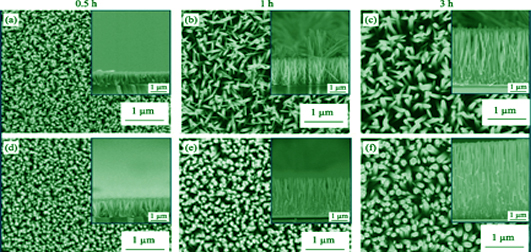
|
|
|
Experimental Study of Multiple Layered SGP Laminated Glass under Hard Body Impact
ZHANG Yang-Mei, WANG Xing-Er, YANG Jian, LIU Qing-Feng, LIU Xin-Wei
2018 Vol. 33 (10): 1110–1118
 Abstract
Abstract(
629 )
 HTML
HTML(
3)
 PDF
PDF(2603KB)(
848
)
Multiple layered SentryGlas®Plus (SGP) laminated glass (LG) is increasingly adopted in the construction sector. The brittle failure of glass under impact leads to the sudden loss of load bearing capacity, however, limited data has been reported to date concerning the impact resistance of multiple layered SGP laminated glass. This paper reports an experimental investigation on the impact performance of triple layered SGP LG panels under hard body impact using a mean minimum breakage velocity (MMBV) test approach. Three categories of breakage sequence were classified by tracing the crack initiation with high speed photos. The impact resistance of SGP LG was calculated by examining the effects of factors such as breakage sequence, support conditions and glass make-ups. The LG panel with the clamped edges required higher MMBV to trigger the glass breakage and had an increase of 44% pre-breakage stiffness than that with the bolted connection. The evident improvement in post-breakage stiffness due to the beneficial crack pattern of heat strengthened (HS) glass, compared to its counterpart of fully tempered (FT) glass, was also revealed, however, the increase in MMBV is modest. The results also showed that a significant degradation of dynamic stiffness can be found in the post breakage stage. Two types of delamination were identified and the dependency of their delamination growth on the impact velocity was analyzed.
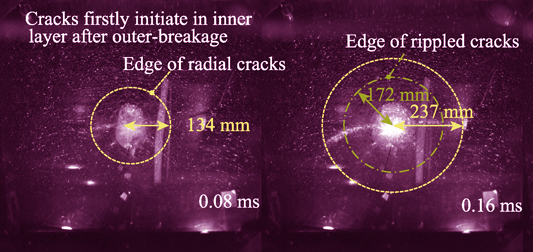
|
|
|
Luminescence Characteristics of Ce: YAG Ceramic Phosphors with Gd3+ Doping for White Light-emitting Diodes
SHAO Xiu-Chen, ZHOU Sheng-Ming, TANG Yan-Ru, YI Xue-Zhuan, HAO De-Ming, CHEN Jie
2018 Vol. 33 (10): 1119–1123
 Abstract
Abstract(
762 )
 HTML
HTML(
6)
 PDF
PDF(567KB)(
1147
)
Ce:YAG ceramic phosphor has outstanding thermal conductivity and chemical stability for application in white light-emitting diodes (WLEDs), thus has a broader application than organic packaging in high-power WLEDs. (Gd,Y)3Al5O12:Ce ceramic phosphors of varying Gd3+ concentrations were fabricated through solid-state reactive sintering method. Through X-ray diffraction, scanning electron microscopy, and fluorescence spectroscopy, the crystal structures, influence of the Gd concentration on fluorescence spectra of Ce:YAG, and luminescence properties of WLEDs with (Gd,Y) 3Al5O12:Ce ceramic phosphors were investigated. As Gd content increased, the Gd3+ replaced the lattice position of Y3+ into the lattice. The absorption of blue light and relative photoluminescence (PL) intensity of the (Gd,Y)3Al5O12:Ce ceramic phosphors decreased as Gd content increased, leading to a reduction in the luminous efficacy from 81.45l m/W to 63.70l m/W. Moreover, the PL emission bands of (Gd,Y)3Al5O12:Ce exhibited redshift from 534 nm toward 564 nm and resulted in increase of the color, rendering index from 61.3 to 70.2. Although doping of Gd decreases the luminous efficacy, the color rendering index of the (Gd,Y)3Al5O12:Ce sample is significantly increased, and the performance of the yellow YAG ceramic phosphor applied to the white LED is improved.
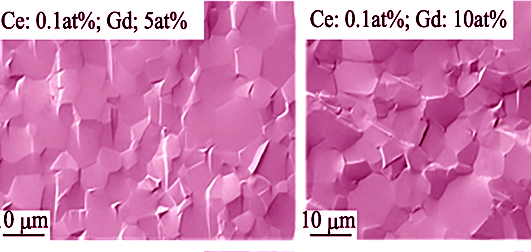
|
|
|
Enhanced Photoreversible Color Switching of Methylene Blue Catalyzed by Magnesium-doped TiO2 Nanocrystals
ZHAO Hai-Bing, XU Hai-Feng, YANG Ke-Wei, LIN Chen-Xue, FENG Miao, YU Yan
2018 Vol. 33 (10): 1124–1130
 Abstract
Abstract(
668 )
 HTML
HTML(
4)
 PDF
PDF(1544KB)(
925
)
Because the advantages of non-direct contact, remote control, high efficiency and fastness, light-driven reversible color switching materials (LDRCSMs) have important applications in information storage, display devices, sensors, and other fields. The combination of inorganic materials and organic materials to achieve synergies is one of the research hotspots of new LDRCSMs. A one-step liquid-phase synthesis method was used to prepare Mg-doped TiO2 nanocrystals (Mg-TiO2 NCs) with a particle size of ~5 nm. The reversible light-responsive color switching of methylene blue (MB) by using Mg-TiO2 NCs was investigated. The results show that Mg2+ doping generates impurity levels in the TiO2 lattice, effectively inhibiting the recombination of photogenerated carriers and increasing the activity of TiO2 photooxidation-reduced MB. On the other hand, Mg2+ doping can decrease the absorption wavelength of TiO2 NCs, which effectively represses the partial reduction of MB to reduced LMB under visible light irradiation, leading to a higher recoloration rate. Such LDRCSMs based on alkali metal-doped TiO2 NCs may have potential application in many optoelectronic device fields.
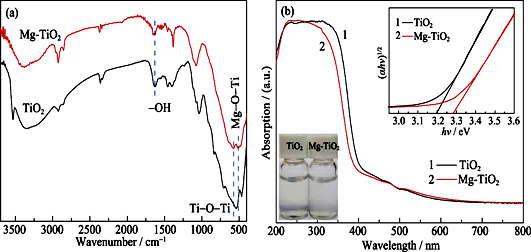
|
|
|
Catalytic Mechanism of Palladium Catalyst for the Oxidation Reduction and Evolution Reaction of Lithium-air Battery
GU Feng, WANG You-Wei, ZHENG Zhi-Hui, LIU Jian-Jun, LU Wen-Cong
2018 Vol. 33 (10): 1131–1135
 Abstract
Abstract(
618 )
 HTML
HTML(
11)
 PDF
PDF(2786KB)(
928
)
Rechargeable lithium-oxygen (Li-O2) batteries have recently attracted great attention due to their superior energy storage density. However, its practical application is seriously limited by some problems such as high charging and discharging overpotential. Metal palladium as a catalyst can simultaneously reduce the charging and discharging overpotential in Li-O2 batteries by enhancing catalytic activity of air electrode, but its catalytical mechanism is insufficient. Here, using first-principles calculations, a three-phase interface model which consists of Pd/O2/Li2O2 is constructed to explore the mechanism of charge and discharge reaction. The result indicates that the Pd/O substrate enhances its adsorption of LiO2 by promoting charge transfer between substrate and Li2O2, thereby accelerating discharge product formed on the electrode surface, and effectively reducing the charging overpotential by 0.43 V.
|
|
|
Anatase TiO2 Nanoparticles: Facile Synthesis via Non-aqueous Precipitation and Photocatalytic Property
JIANG Feng, YU Yun, FENG Ai-Hu, YU Yang, MI Le, SONG Li-Xin
2018 Vol. 33 (10): 1136–1140
 Abstract
Abstract(
1013 )
 HTML
HTML(
18)
 PDF
PDF(2889KB)(
1087
)
A facile strategy for anatase titanium dioxide (TiO2) nanoparticle preparation was proposed via a non-aqueous precipitation method. With the aid of glacial acetic acid, tetrabutyl titanate underwent non-hydrolytic reaction in solvent ethanol. Glacial acetic acid increased polarity of Ti-O and C-O bonds of tetrabutyl titanate, and promoted non-hydrolytic de-etherization poly condensation reaction to form Ti-O-Ti bond in the solvent. After refluxing at 80℃ for 24 h, the Ti-O-Ti bond was rearranged to form anatase TiO2 nanoparticles with the particle size of 5 nm-20 nm and specific surface area of 169.4 m2/g, which exhibited good dispersion and excellent photocatalytic activity. The degradation rate against methyl orange under ultraviolet radiation for 2 h reached 99.81%, showing promising prospect in wastewater treatment process.
|
|
|
Influence of Film Thickness on the Electrochemical Performance of α-SiOx Thin-film Anodes
MENG Xiang-Lu, HUO Han-Yu, GUO Xiang-Xin, DONG Shao-Ming
2018 Vol. 33 (10): 1141–1146
 Abstract
Abstract(
688 )
 HTML
HTML(
9)
 PDF
PDF(7540KB)(
1064
)
SiOx anodes of lithium ion batteries have attracted considerable attention in recent years, due to their cycle stability, large capacity, and feasibility on composition manipulation. Many previous works have focused on clarifying the influences of oxygen contents on SiOx based anodes. However, the size effect is still far from understanding. Herein, the size effect on electrochemical properties of SiOx with thin-film type anodes in different thickness was investigated. It is found that the SiOx electrodes prepared by sputtering is of a Si/O ratio of 0.7 and exhibits the highest initial Coulombic efficiency (ICE) of 71.68% and the highest capacity retention of 92.01% when the film thickness being 450 nm, compared with those in other thickness. The best performance under such intriguing thickness-performance relationship is attributed to the low charge transfer resistance, formation of the reduced SEI layer and good electrode integrity upon cycling, as evidenced by SEM images and EIS collected during cycling. These results indicate that as anodes of LIBs, the SiOx anodes with controlled size can greatly improve the electrochemical performance.
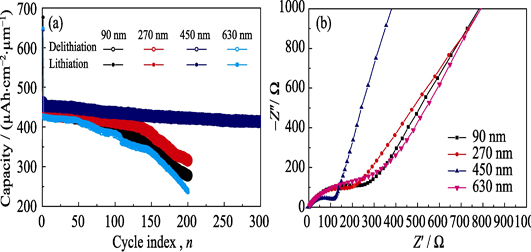
|
|